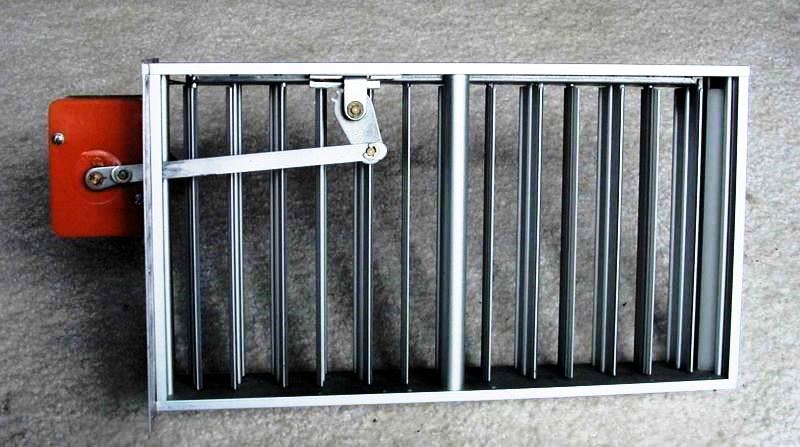A damper is a valve or plate that stops or regulates the flow of air inside a duct, chimney, variable air volume box, air handler, or other air handling equipment. A damper may be used to cut off central air conditioning to an unused room, or to regulate it for room-by-room temperature and climate control. Its operation can be manual or automatic.
Manual dampers are turned by a handle on the outside of a duct. Automatic dampers are used to regulate airflow constantly and are operated by electric or pneumatic motors, which are in turn controlled by a thermostat or building automation system.
Automatic or motorized dampers may also be controlled by a solenoid, and the degree of air-flow calibrated (perhaps according to signals from the thermostat going to the actuator of the damper) in order to modulate the flow of air-conditioned air in order to effect climate control.
ZONE DAMPER
A zonedamper is a specific type of damper used to control the flow of air in a heating, ventilation, air conditioning (HVAC) system. In order to improve efficiency and occupant comfort, HVAC systems are commonly divided up into multiple zones. For example, in a house, the main floor may be served by one heating zone while the upstairs bedrooms are served by another. In this way, the heat can be directed principally to the main floor during the day and principally to the bedrooms at night, allowing the unoccupied areas to cool down.
Zone dampers as used in home HVAC systems are usually electrically powered. In large commercial installations, vacuum or compressed air may be used instead. In either case, the motor is usually connected to the damper via a mechanical coupling.
For electrical zone dampers, there are two principal designs. In one design, the motor is often a small, shaded-pole synchronous motor combined with a rotary switch that can disconnect the motor at either of the two stopping points. In this way, applying power to the open damper terminal causes the motor to run until the damper is open, while applying power at the close damper terminal causes the motor to run until the damper is closed.
The motor is commonly powered from the same 24 volt AC power source that is used for the rest of the control system. This allows the zone dampers to be directly controlled by low-voltage thermostats and wired with low-voltage wiring. Because simultaneous closure of all dampers might harm the furnace or air handler, this style of damper is often designed to only obstruct a portion of the air duct, for example, 75 percent.
Another style of electrically powered damper uses a spring-return mechanism and a shadedpole synchronous motor. In this case, the damper is normally opened by the force of the spring but can be closed by the force of the motor. Removal of electrical power re-opens the damper. This style of damper is advantageous because it is fail safe; if the control to the damper fails, the damper opens and allows air to flow.
However, in most applications, fail safe indicates the damper will close upon loss of power, thus preventing the spread of smoke and fire to other areas. These dampers may also allow adjustment of the closed position so that they only obstruct, for example, 75 percent of the air flow when closed.
For vacuum- or pneumatically-operated zone dampers, the thermostat usually switches the pressure or vacuum on or off, causing a spring-loaded rubber diaphragm to move and actuate the damper. As with the second style of electrical zone dampers, these dampers automatically return to the default position without the application of any power, and the default position is usually open, allowing air to flow. Like the second style of electrical zone damper, these dampers may allow adjustment of the closed position.
Highly sophisticated systems may use some form of building automation to control the zone dampers. The dampers may also support positions other than fully open or fully closed, are usually capable of reporting their current position, and, often, the temperature and volume of the air flowing past the smart damper. Regardless of the style of damper employed, the systems are often designed so that when no thermostat is calling for air, all dampers in the system are opened. This allows air to continue to flow while the heat exchanger in a furnace cools down after a heating period completes.
Zone dampers
Advantages:
- Cost.
- Power consumption.
Disadvantages:
- New US residential building codes require permanent access to dampers through ceiling access panels.
- Zone dampers are not 100% reliable. Most styles of motor-to-open/motor-to-closed electrically operated zone dampers aren’t “fail safe” (that is, they do not fail to the open condition). However, zone dampers that are of the “Normally Open” type are fail-safe, in that they will fail to the open condition.
- No inherent redundancy for the furnace. A system with zone dampers is dependent upon a single furnace. If it fails, the system becomes completely inoperable.
- Low total flow when only some dampers are open can cause inefficient operation.
- Supply and return ducts need dampers to avoid pressurization of portions of the building.
- The system can be harder to a design, requiring both “SPDT” thermostats or relays and the ability of the system to withstand the fault condition whereby all zone dampers are closed simultaneously.
